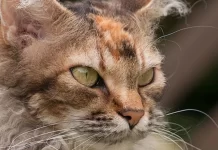Last Updated on August 19, 2023 by Fumipets
Manx Cats: The Complete Info Guide
Manx Cats is a comprehensive overview of the unique breed known as the Manx cat. This article delves into the history, characteristics, genetics, and care considerations of these tailless or short-tailed felines.
It discusses their origins on the Isle of Man, the genetic mutation responsible for their distinctive trait, and the various types of Manx cats. The article also covers their temperament, health considerations, and tips for providing proper care.
Manx Cats
Manx cats have all the wonderful cat flavor you love, but with a tail that is up to 100% shorter. They are rather like the diet sodas of the cat fancy.
The Manx cat breed, which has a naturally occurring genetic mutation that shortens the tail, has long held sway on Britain’s Isle of Man, a tiny island in the Irish Sea. Manx have been favored by sailors and farmers for nearly as long as they have existed. They are known for their peaceful, modest, sweet personalities and their famous hunting ability.
Appearance
The Manx word of the day is, to start, “round.” Their rumps sit over their front shoulders as they stand or walk, giving them a rounded look. Their heads are round, their eyes are round, their ears have a rounded shape, and their rear legs are visibly longer than their front.
The Manx has been said to as looking and acting “rabbit-like” in his movements. This particular cat breed often walks by hopping like a bunny by using both of its hind legs simultaneously.
Manx are robust shedders with thick, double-coated hair that is very resistant to cold and wetness. All-white coats or color-pointed Manx are the rarest, whereas orange, tabby, and tortoiseshell are the most prevalent color and pattern combinations seen in Manx cats.
There are long-haired cats with the same genetic composition as short-haired cats. There is considerable disagreement about how they are handled. The Cat Fanciers Association (CFA) claims that the Manx may have either long or short hair, but shows all of them as having short hair, regardless of the length of their real coats. The long-haired cats, also known as Cymrics, are recognized as a different breed by several regulating organizations in Europe and Asia.
A genetic mutation that occurs spontaneously is the cause of the Manx’s absence of a tail. This, together with the island’s tiny size and isolation, enabled the dominant-gene characteristic to proliferate throughout the population of cats on the Isle.
Manx cats, although being known for lacking tails, may fall into one of five categories:
Rumpy (or rumpie): Although there may sometimes be a hair tuft where the tail would have developed, these cats do not have any tails at all.
Riser or rumpy riser: Cats with a cartilage hump under the fur. This lump will often increase when the cat is joyful or when their rumps are stroked.
Cats who are born with a partial tail made up of remnant, fused vertebrae, generally measuring about an inch in length, are called stumpy (stumpie).
A Manx with a short tail of non-fused bones, up to the length of an ordinary cat tail, is referred to as a “stubby” (stubbie), “shorty,” or “short-tailed.” These tails can move and function precisely like a conventional tail, minus their length.
Manx with a tail that is half to full length is known as a longy or taily.
Only rumpies and stumpies are permitted to compete in the Manx division. Stubbies and longies are still permitted to compete in the CFA, but they must fall into the ‘any other’ category. They are both crucial in breeding stock, however, since marrying two rumpies may result in major health issues.

Temperament
The Manx is a calm and laid-back cat. Although they have a strong sense of independence, they are devoted to their families and often follow their favourite people at home.
According to Bruce Kornreich, DVM, PhD, director of the Cornell Feline Health Centre, “generally speaking, they are pretty social; they are fairly intelligent and playful.” certain humans have said that they may exhibit certain canine traits, such as the ability to learn to retrieve objects and perhaps respond well to vocal directions.
Manx are known for their hunting skills. They have long been used as ratters aboard ships of various kinds and are highly sought by farmers for their propensity for taking on bigger prey, such as rats and voles.
Living Needs
There aren’t many unique needs or preferences for a Manx person. They are fairly energetic cats that like to play fetch and are easily taught to recognise verbal cues and clicker signals. More than explorers, Manx are skilled jumpers and natural hunters; if your Manx vanishes for a long, she’s usually on the trail of something.
As long as they are introduced to their new furry siblings gradually, Manx will be a kind, sweet-tempered addition to households with children and several pets.
According to Kornreich, it’s crucial to provide a new cat with a comfy place.
“Give the cat a place where he or she could retreat to and feel safe in, so a room with a litter box, food and water bowls, and that sort of thing,” he advises. He advises keeping the new kitten there while introducing it to the others gradually via smell and eventually sight.
The most crucial aspect of introducing cats to kids, says Kornreich, is teaching the cat to approach the kid rather than the other way around. “Because youngsters often get overexcited and may attempt to pick up the cat, grab something, or corner the cat, all of which might pose a problem. I believe that allowing the cat to approach the youngster and praising it for good behaviour would be appropriate. Possibly letting the kid bring treats. It’s crucial to provide positive feedback verbally for actions that are beneficial.
Care
The double coat of the Manx usually needs fairly continual maintenance. The best technique to keep loose hair to a minimal and to keep coats appearing smooth and tangle-free is to brush every day. Expect the seasons of shedding to be particularly enjoyable as both coats—long and short—lose some heft.
Like other cats, your Manx has to have his claws clipped to prevent him from clicking over the floor or unintentionally scratching you when you’re cooking biscuits. To prevent him from becoming bored, keep his litter box tidy and make sure he has access to toys that he may seek and scratch on.
Health
There are health concerns related to a Manx’s taillessness that need be taken into consideration. Manx syndrome, according to Kornreich, is the main cause of worry.
The term “Manx syndrome” refers to a disorder that develops when the tailless gene causes the spine to shorten excessively. Severe spinal cord nerve injury may cause issues with the intestines, bladder, and gastrointestinal system. Depending on the amount of the harm and which portions of the GI tract are damaged, this may result in problems like incontinence or constipation, Kornreich claims.
A painful type of arthritis is more common in those Manx with partial tails. According to Kornreich, individuals with short tails may also be more prone to bacterial infections in the fold of their tail.
A hereditary disorder termed corneal dystrophy, in which the cornea grows improperly, is also prone to the breed.
Finally, certain tailless cats, like the Manx, may develop megacolon, a chronic illness (a dilated, flaccid colon) that causes constipation and, if untreated, may be fatal to the cat.

History
On the Isle of Man, the Manx have existed for millennia. They were probably undoubtedly produced when a cat with a spontaneous short-tailed mutation was transported to the island, most likely by either Nordic or Spanish seafarers, but their precise origin is a subject of considerable contention. The Manx gene became the predominant characteristic in the island’s cat population as a result of the island’s tiny size, relative isolation from the mainland, and significant penetration of the mutation.
The genetic process behind the reduced tail length and the genes that regulate tail length are currently being studied to determine the precise reasons for taillessness, which are particular to the Manx breed, according to Kornreich.
It has been somewhat shown that there is a gene for taillessness, although it just affects whether the tail will develop or not. Because Manx cats may have tails of all lengths, from no tail to a stub to kind of a half-tail, and in other circumstances they could have a normal-length tail, it doesn’t specify how long.
There are other short-tailed cats than the Manx, and not all non-tailed cats are Manx. Breeds like the Japanese bobtail are believed to have originated separately but in a similar way (genetic mutation meets geographic isolation).
Manx have been around for at least three centuries; they were first mentioned in literature in 1807 as a reputable breed. The Manx was one of the founding breeds when the CFA was established in 1904.
Questions & Answers:
What makes Manx cats distinct from other breeds?
Manx cats are known for their distinctive lack of a tail or having a short tail, resulting from a genetic mutation. This mutation also gives them a distinctive, rounded appearance and unique gait.
What is the history of Manx cats?
Manx cats originated on the Isle of Man, a small island between England and Ireland. They’ve been part of local folklore and culture for centuries, with historical records and legends tracing their presence back to the 18th century.
How is the taillessness trait inherited in Manx cats?
The taillessness trait in Manx cats is caused by a dominant genetic mutation. However, breeding two Manx cats with this mutation can result in kittens with severe health issues, so it’s important to be mindful of responsible breeding practices.
What are the different tail types in Manx cats?
Manx cats can exhibit several tail variations, including “rumpies” (completely tailless), “stumpies” (short tails), and “longies” (tails of varying lengths). The length and type of tail can vary within a single litter.
What is the temperament of Manx cats, and how should they be cared for?
Manx cats are often described as friendly, playful, and social. They tend to form strong bonds with their owners and can get along well with other pets. Care involves providing a balanced diet, regular exercise, and routine veterinary check-ups to address potential spinal and pelvic issues associated with the taillessness trait.
“Manx Cats” offers insights into the history, genetics, and care requirements of these unique felines, helping potential owners better understand and appreciate the distinct characteristics and needs of Manx cats.


















